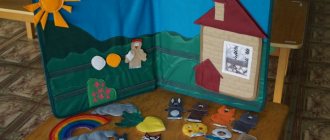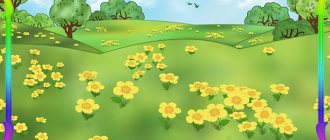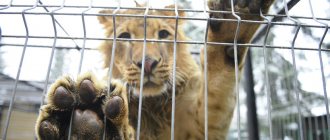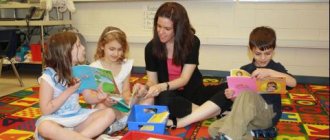Project "Where the book came from"
author:
Gagarina Galina Anatolevna
senior teacher of MBDOU "Kindergarten No. 25 in Vyborg"
Novikova Alexandra Alekseevna
teacher at MBDOU "Kindergarten No. 25 in Vyborg"
Project "Where the book came from"
Municipal budgetary preschool educational institution
"Kindergarten No. 25 in Vyborg"
Educational research project
"Where the Book Came From"
Prepared by: senior teacher
Gagarina Galina Anatolevna
teacher
Novikova Alexandra Alekseevna
Vyborg 2018
Explanatory note
Problem:
In the modern world, people are less and less likely to pick up a book, read them, and even less think about how a book is born. Book culture is changing radically these days. The main reason is the development of science and modern technologies, the emergence of new methods of obtaining information. Reading books and reading culture is a pressing problem.
Project type:
educational and research
Project duration:
short-term (1 week)
Project goal (for the teacher):
To create conditions for the development of cognitive and creative abilities, to maximally enrich children’s knowledge and ideas about how a book is created.
Project objectives:
- Introduce children to the history of the creation of the first books. Enrich children's understanding of how a book is made from what material
- Expand knowledge about professions related to books, librarian, writer, editor, illustrator
- Bring children to understand that books must be treated with care so that the books live as long as possible.
- Develop the ability, together with parents, to find an original solution when creating pages of a handmade book.
- Develop the ability to communicate freely with adults and children, to show friendly relations with each other
- To foster in children an interest and love for books.
Project goal (for children):
Find out how a book is created, what professions people help it appear on bookshelves.
Expected result:
—
children's interest in reading fiction will increase;
growth of positive dynamics in the formation of children's ideas about the book and the rules for handling it;
— the level of creativity in artistic, speech, productive and gaming activities will increase;
— the level of parents’ competence in matters of introducing children to reading fiction through cognitive and research activities will increase.
Project participants:
children of senior preschool age, parents, teachers,
Motivation of children and parents (immersion in the project):
The teacher lays out several objects made of wood on the table, invites the children to look at them and say what unites them. Do you know why there is a book among them? Do you want to know how books appear, where they came from?
| Child planning by (shape: general circle) | Creating conditions through the organization of a subject-spatial developmental environment according to activity centers | Joint forms of educational activities between adults and children | Results of the day | ||
| Monday Let's find out where the book came from, the creation of the book | Exhibition of books, portraits of writers Stones, tablets, birch bark, pieces of leather, fabric, sheets of paper, paints, brushes, felt-tip pens | Conversation about the history of book creation with presentation "Where the Book Came From" Reading the story by A. Barkov and R. Suryaninov “Where the book came from” Drawing a picture on stones, birch bark | Quiz: “All about books” Making a book cover | ||
| Tuesday Let's learn about the properties of paper | Collection of paper, collection of paper, algorithm for creating a book, waste and natural material, plasticine Paper napkins of different colors, bowl of water, sieve, bucket, board for rolling out paper, rolling pin | Conducting experiments Paper cuts, tears, wrinkles, gets wet, absorbs oil, makes sound, flies, burns Conversation “What can a book be made from?” “What kind of paper can you make a book from?” “What properties of paper do you know?” | Making paper from napkins | ||
| Wednesday Let's find out who illustrators are | Illustrations for books Paints, markers, colors. pencils, paper | Conversation about the diversity of artistic genres D/game: “Genres of books”, “Guess the title of the book”, “One - many” Developing educational situation: “Who and how they create pictures in books.” Conversation “Why do we need illustrations in books?” | Drawing an illustration for your favorite fairy tale | ||
| Thursday Let's find out who writes books | Attributes for conducting the role-playing game “Publishing House”, “Library” Algorithm for making a bookmark | Solving a problem situation: “Books have disappeared from the group” Conversation “What writers do you know?” Reading a poem by S.Ya. Marshak "How the book was printed." Conversation “The librarian profession, what do you know about it?” | Role-playing game “Publishing House”, “Library” Making a bookmark for a book | ||
| Friday Let's find out what a book is made of and how it is created | Paper collection, book making algorithm Paper, glue, scissors | Conversation about the structure of the book (cover, pages, binding, illustrations) With presentation Memorizing the poem by Valentin Berestov “How to be able to read well” Repairing damaged books Physical school | Making a baby book | ||
| Interaction with parents | |||||
| Questionnaire for parents “Child and Book” Let's compose the story “My favorite book” Consultations, folders for parents: “Smart books for smart kids”, “Which book to choose for a child”, “Recommendation list for shared reading with children of senior preschool age” Weekend excursion: Library, bookstore. Making little books - “a book about a book” | |||||
| Interaction with social partners. Excursion to the library “What is illustration?” | |||||
| Note “Literary Minute” is held every day. Reading the story “Where the book came from” by A. Barkov and R. Suryaninov, poem by S.Ya. Marshak “How they printed a book”, E. Tvorogova “The Tale of Books”, L. Potsepun the fairy tale “The History of a Book”, V. Gaevskaya “In the zoo they gave all the monkeys colorful books” | |||||
| What new did you learn? — we find out where the book came from, the creation of the book; — learn about the properties of paper; — find out who illustrators are; — find out who writes books; — find out what a book is made of and how it is created | Our successes We made a little book, conducted interesting experiments, made bookmarks for books, felt like illustrators and writers. | What else do we want to know? — where did the fairy tale come from? - what kind of fairy tales are there? - What is an encyclopedia? | |||
Project "Where the book came from"
ABC
The first schools in Rus' appeared after Epiphany. The entry in the Tale of Bygone Years says that Prince Vladimir “sent to collect children from the best people and send them to book education.” At the same time, “the mothers of the children wept for them, for they were not yet established in the faith, and wept for them as if they were dead.”
Ivan Fedorov. Image: publiclibrary.ru
"ABC" by Ivan Fedorov. Image: expositions.nlr.ru
"ABC" by Ivan Fedorov. Image: sovershenstvo-mysli.ru
The main children's reading was church books, most of which were handwritten translations from Byzantine. The first Slavic printed “ABC” was created by Ivan Fedorov in 1574 “for the sake of rapid infant learning.” Researcher Ben Hellman in the book “Fairy Tale and Reality. History of Russian Children's Literature" writes that a child had to learn to read in order to study the Holy Scriptures himself. Fedorov's book consisted of three parts: the first - the alphabet, the second - grammar, and the third - reading materials. Self-study texts included prayers and passages from the Bible. “If honey is sweet to the tongue, knowledge and teaching are so useful to a person,” the alphabet indicated.
In the 15th–17th centuries, a textbook was considered the main and only children's book. Books were quite expensive for the average family. A record by Archbishop Athanasius of the purchase of church books has been preserved: the New Testament was purchased for three rubles, “Peace with God” for one ruble and “The Key of Understanding” for four rubles. At that time, you could buy a horse with this money. Therefore, for a long time, books were considered entertainment, on which it was a pity to spend the family budget, and fairy tales and epics were memorized by heart and passed on from mouth to mouth.
First poetry
It is believed that Russian poetry for children traces its history back to the beginning of the 17th century, when in the Primer, in addition to church texts, the author’s poem by Savvaty, the reference director of the Moscow Printing House, was first published. The poems were edifying: the poet advised young readers to abandon “all philosophizing” and work hard and reminded them of the harm of “laziness and negligence to everyone in learning.”
Savvaty Solovetsky. Image: monasterium.ru
Simeon of Polotsk. Image: posmotrim.by
“The Big Primer” by Karion Istomin (fragment). Image: mynnm.ru
Another poet, the monk and theologian Simeon of Polotsk, is known as the creator of the Primer of the Slovenian Language. Polotsky was also the author of poetic books for the Tsar’s children; in particular, he created a collection of moral and instructive stories, “The Many-Colored Wind City.”
Another court poet, Karion Istomin, wrote a book about raising children, which he called “Domostroy” - by analogy with the famous work of the same name by the priest Sylvester. Istomin noted that children more easily learn the rules of good manners and Christian morality from short poems. He also published The Big Primer, where illustrations first appeared. This manual was reminiscent of modern ones: each page was devoted to one letter, and the engravings depicted objects and animals whose names began with the letter.
Tales for princes
During the Peter the Great era, the number of publications for children increased. Books on etiquette appeared, the most famous of which was “An Honest Mirror of Youth,” a textbook on European social manners. Educated children of the 18th century were fond of foreign novels - they translated mainly French, German and English books. Aesop's fables, Robinson Crusoe and Gulliver's Travels were popular.
Portrait of Catherine II. Painting by Fyodor Rokotov. 1735–1808. State Hermitage Museum, St. Petersburg
Catherine II. The fairy tale “About Tsarevich Chlor”. Image: pushkinmuseum.ru
Catherine II. The fairy tale “About Tsarevich Fevey”. Image: arch.rgdb.ru
Domestic children's books also appeared in the 18th century. Among the authors who turned to literature for children was Catherine II herself. The Empress was inspired by the pedagogical ideas of the French philosopher Jean-Jacques Rousseau that a child should develop in accordance with his age. For her grandchildren, Catherine published an ABC book and wrote two fairy tales: “About Tsarevich Chlorus” and “About Tsarevich Fevey.” These books are today considered the first children's works in Russian. Both stories were allegorical and didactic in nature. For example, the hero of the first fairy tale, Prince Chlorus, was looking for a rose without thorns with the help of advisers - Reason, Honesty and Truth - in order to become a better ruler.
Letterman
Another author of children's books of this era was Professor Kurganov. He created the “Pismovnik” - a grammar of 1769, where “the science of the Russian language with many additions of various educational and useful amusing verbiage” was collected. “Pismovnik” became a universal guide to the Russian language, in which, in addition to information about grammar, one could find poetry, folk proverbs, fairy tales and short anecdotal stories. For example, satirical poems:
Oh, how happy are those yellow grains of sand that you stepped on! Oh, and how beautiful are the soft blades of grass that lay beneath you!
Kurganov himself wrote in the preface about the benefits of entertaining reading and that such a text “has fun, enriches thoughts and enlightens the mind,” since it contains “a lot of moralizing and something that will serve as a useful and pleasant exercise.”
Nikolay Kurganov. “Writer. Part one". Image: imwerden.de
Nikolay Kurganov. “Writer. Part one". Image: imwerden.de
Nikolay Kurganov. “Writer. Part two". Image: imwerden.de
The Letter Book was an incredibly popular book that could be found in every educated family. Among his fans were writers Alexander Herzen, Nikolai Gogol and Alexander Pushkin. The latter’s character from “The History of the Village of Goryukhin” recalled: “My parents, respectable people, but simple and brought up in the old-fashioned way, never read anything, and in the whole house, except for the ABC, bought for me, calendars and the Newest Letter Book, there were no books.” was located. Reading a letter book has long been my favorite exercise. I knew it by heart and, despite that, every day I found new unnoticed beauties in it.”
Researchers believe that the "Pismovnik" owes its popularity to its fictional part - "Brief Intricate Stories." It was a collection of funny and entertaining stories, parables and stories. They ridiculed, for example, the passion of secular society for coffee: “Since coffee serves as the main cure for sadness, then a certain lady, notified that her husband was killed in the war, - “Oh, unhappy!” “- she cried, “bring the coffee soon,” and she immediately became cheerful.” Human vices were also discussed: “A certain lady, restless in her chatter, asked the doctor why her teeth were falling off. He responded to her: “Because, madam, you often deign to hit them with your tongue.”
First stories
For the ancient Russian chroniclers, who were the authors of a kind of prose literature, the concept of “age psychology” did not exist, and therefore there was no prose designed for children in Rus' until the middle of the 17th century.
Philologist Irina Arzamastseva says that at that time the process of transition from educational literature to works of artistic and scientific-educational orientation began: “The educational book gave the child ready-made information that only had to be memorized. Such a book was aimed at one-sided thinking of the reader, accustoming him to someone else's monologue. In parallel, literature is developing, building a dialogue with the child, reflecting his childish “I”, answering his “why”.
In the middle of the 17th century, they began to rework, shorten and simplify knightly and Russian military stories: “The Tale of the Massacre of Mamayev”, “The Tale of Eruslan Lazarevich”, “The Tale of the Siege of the Don Cossacks”, “The Tale of Peter and Fevronia”. The genre of the story also began to take shape: one of the early stories tells the story of a criminal son who, on the way to execution, bit off his mother’s ear. He explained this by saying that his mother was the culprit of his death, since she did not punish him for the first theft.




